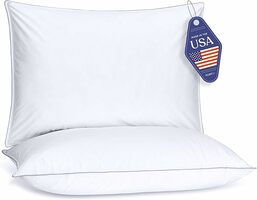Pillows are essential for comfort, style, and a great night’s rest. BuyersReport's experts have broken down the features, & benefits of the top-rated, most effective options so you can make an informed choice – our comprehensive review can help you find the best pillows for every sleep style, from side to back to stomach sleepers.
 Beckham Hotel Collection
Beckham Hotel Collection
 Royal Therapy
Royal Therapy
 Fluffco
Fluffco
 Coop Home Goods
Coop Home Goods
 Sleepavo
Sleepavo
 Beckham Hotel Collection
Beckham Hotel Collection

One of the most essential items needed for a good night’s sleep, your pillow is truly the workhorse of your bedroom setup, and yet it often doesn't receive the credit it deserves. There to keep your head and neck supported as you slumber, this core component of your nightly routine ensures you wake up feeling rested and rejuvenated, and it can help prevent common aches and pains that might otherwise plague your day. However, what makes a pillow great isn’t always the same for every sleeper, and what you find to be comfortable and supportive may not necessarily be the ideal choice for someone else. Because of this, there are a lot of factors that need to be taken into consideration when shopping for an upgrade, and it’s essential that you understand your own unique needs, preferences, and sleeping habits before you settle on a specific model. Thankfully, this buying guide was created to help you accomplish all of that with ease, and if you've found yourself tossing and turning more than usual due to a lumpy, worn-out pillow, then this article was made for you. Covering everything from sleeping positions to the types of fill you can expect to encounter, our guide dives deep into the complex and intriguing world of pillows, and will ensure you walk away with all of the information you need so you can get back to having the best sleep of your life.
When it comes to pillows, finding that perfect option can be quite a challenge, and there is usually a long period of trial and error before you finally settle on that ideal pillow that feels like it was custom made for your needs. Because of this, most people try to avoid changing their pillow for as long as possible, as the thought of having to try and find a suitable replacement can be quite overwhelming and daunting. However, pillows aren’t made to last a lifetime, and most experts do recommend swapping out your pillow on a fairly regular basis in order to ensure you’re still enjoying all of the health and wellness benefits that come with a great night’s sleep. Realistically, this means that you should only be keeping your pillows on your bed for about 1 to 2 years before you need to replace them, and there are some key signs you will want to look out for that could indicate that an upgrade is now necessary.
If you’re noticed your pillow is laying a little flatter than normal, has begun to develop some yellow staining, or has started to have uncomfortable lumps that are affecting your sleep, these could be clear indicators that it's time to bid farewell to your old pillow and welcome a new, more supportive sleep companion. Other red flags that signal the need for a pillow replacement could include an unpleasant odor, on-going neck pain, or even an increase in day-to-day allergies that don’t seem to be limited specifically to certain seasons. In general, it’s always best to err on the side of caution when it comes to making a decision about upgrading, and if you feel that your pillow is no longer providing the comfort and support you need for a good night's sleep, then that’s always a good enough reason to begin the shopping process so you can find a suitable replacement.
What position you find yourself sleeping in at night can have a direct impact on the type of pillow that’s best for you, and because of this, it should be the first thing you take into consideration before you start shopping. Are you exclusively a side sleeper? Are you most comfortable on your back? Or do you frequently shift around, moving from your side, to your back, and even onto your stomach, before the night is over? While it may initially seem unimportant, your favorite position will help you determine not only the style of pillow you need, but also the correct height, and tailoring your purchase to your preferences will go a long way in ensuring you get a great night’s sleep.
If you find yourself laying on your side whenever you fall asleep, then the main thing you’re going to require is a loftier pillow that helps to fill in the gap between your shoulder and your ear. Pillows that are too thin won’t be able to give you the support you require to maintain proper spinal alignment while you sleep, and this can quickly lead to on-going pain and discomfort, especially in the neck and shoulder area. A firmer pillow will also be necessary in order to give you that extra support night after night, as this will prevent your head from sinking down too low causing strain on your neck muscles.
Falling right in the middle when it comes to both loft and firmness, back sleepers tend to benefit most from a pillow that is neither too hard, nor too soft, and that won’t raise your head up too high, or keep it too low to the bed. When you lay down, you should feel your head sinking into the pillow slightly, and this is a good indicator that you’re going to be able to keep your head supported without causing unnecessary stress or strain. If you find your chin is jutting upwards when you lay down, or it’s starting to fall towards your chest, then these are both indicators that the loft you’ve selected isn’t right for your preferred sleep position, and adjustments may be necessary to achieve a perfect balance.
Those who tend to prefer sleeping on their stomach may find pillow shopping to be the most challenging, as this unique position is not only uncommon, it can actually be the worst for your body. In this position, you tend to put a lot of strain on your neck throughout the night, and it can also put unnecessary pressure on your lower back, as well on your abdomen. However, if sleeping on your stomach is unavoidable then finding the right pillow is extra important, and the ideal solution for you will be something that is quite thin, and quite soft. The last thing you want is to be tilting your head upwards while you slumber, so always opt for the lowest loft you can find, and if possible, aim to purchase an adjustable pillow that will enable you to achieve the perfect fill density so you can maintain a more neutral spinal alignment.
Pillow shopping is fairly straightforward when you typically sleep in a single position throughout the night, but what happens if you’re someone who tosses and turns, moving from one position to another all night long? In this case, the best choice is almost always going to be a more middle-of-the-road option, similar to what you would select as a back sleeper, as this will give you a bit of versatility when it comes to your preferred positions. The other option would be to try and determine which position you tend to spend the greatest amount of time in, and then focus on purchasing the pillow that will give you the correct support and comfort in your primary position. In some cases, an adjustable pillow could be a worthwhile investment since it will also enable you to adapt the loft as necessary, allowing you to make adjustments whenever you feel extra strain or discomfort.
Once you’ve determined the correct loft and firmness that matches your preferences and needs, the next step in the shopping process is going to be deciding which type of fill you want inside of your new pillow. From down to buckwheat, there is a lot of variation that exists in the market, and this tends to be the one characteristic that people get the most confused about. However, it is important that you take the time to truly understand the pros and cons of each option available to you, as the materials used will greatly impact how soft the pillow feels, how supportive it is, and even whether it’s machine washable or if it needs to be spot-cleaned by you. The different fill materials can also have a big impact when it comes to the total price of the pillow, so those on a budget may find they want to avoid certain options in order to save some money, while others may want to splurge on a more luxurious option.
One of the more expensive options available, down is made from the soft clusters found beneath the outer feathers of ducks or geese, and it is a very popular choice for anyone who prefers a softer, more cloud-like feel with their pillows. Highly compressible, down does a great job of molding perfectly to the shape of your head and your neck, and it can provide you with a superior loft that is supportive long-term. The downside to down, however, is that its higher price tag can be a barrier for more budget-conscious shoppers, and it’s also a known allergen that may trigger a reaction in certain individuals.
If you love the idea of a down pillow but have either ethical concerns or a known allergy, then opting for a down alternative pillow could be a good solution. Made from a synthetic fill, these pillows tend to still be quite soft and supportive, and they are almost always going to be more budget-friendly than their genuine down counterparts. Where they fall short, however, is that they are known for being a lot less durable and long-lasting than a high-quality down pillow, and they may not maintain their loft as effectively night after night.
Available in two distinct varieties, memory foam pillows have become increasingly popular in recent years, and for good reason. With their ability to give you significant support and conform to the shape of your head and neck, memory foam pillows are often praised for their comfort and pressure-relieving properties, and this is true for both shredded memory foam, as well as solid options. Known to be durable and long lasting, this popular fill type does a great job of ensuring you maintain proper spinal alignment while you sleep, and its durable nature means it won’t start to go flat too quickly. But while memory foam has a lot of benefits, it does also have some notable drawbacks, and thanks to its density and weight, it may not be a good choice if you tend to get hot at night.
At first glance, you may be surprised to learn that buckwheat, the same grain used in pancakes, can be a filling for pillows, and you certainly wouldn’t be alone in thinking that this sounds incredibly odd and possibly uncomfortable. But the reality is that buckwheat is quickly gaining traction as a preferred fill material for a number of reasons, and if you’re tired of pillows that never feel quite comfortable enough, or quite supportive enough, then this highly adaptable option might be perfect for you. Easy to adjust for a more personalized experience, buckwheat is a natural and eco-friendly fill type that can provide firm and consistent support for your head and neck, and its open structure makes it quite breathable which is perfect for hot sleepers. With that said, if you’re sensitive to sound, buckwheat may not work for you, as the hulls do create a rustling sound as you shift around and this noise can be distracting for some individuals as they try to fall asleep.
Shopping for a new pillow is a very personal experience, and in order to walk away with the perfect pillow for your needs, you need to be focusing on both your individual preferences as well as your overall sleep habits. What position you are most comfortable in is going to be one of the biggest considerations, as this will help you select the correct height, as well as the ideal firmness. From there, you can then start to look at all of the fill options that are available to you, and manufacturers now offer a wide range of options that include everything from premium down to eco-friendly buckwheat. On top of sleep position and fill, you’ll also want to spend some time thinking about your budget, any allergies you may have, and whether or not you tend to run hot at night, as these factors can also impact how satisfied you are with the pillow you choose. If you’re unsure, one of the best things you can do is to select a pillow that offers an at-home sleep trial period, as this will allow you to try it out for yourself, in your own environment. If that’s not possible, taking the time to read reviews can be incredibly beneficial, and as long as you’re doing your research, and focusing on your needs, you’re likely to end up with that perfect solution that makes you feel like you’re sleeping in a 5 star hotel night after night.